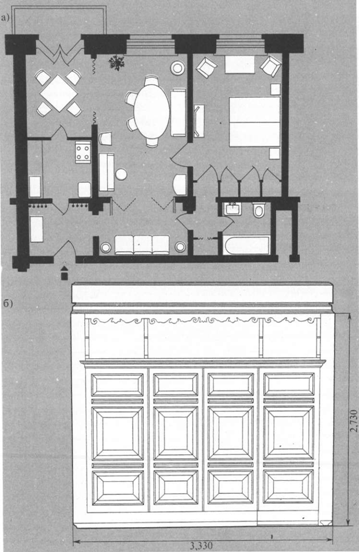
Foreign experience
The beginning of a new era of material culture — the era of industrial production — is associated with the First World Industrial Exhibition in London in 1851.
The development of new applied art, including furniture, was greatly influenced by a group of English artists: W. Morris, Raskin, Bern-Jones, and others, who began to struggle with eclecticism and were inspired in their work by the art of the early Middle Ages. In the furniture, decorative fabrics, they sought to revive hand craft. Despite the fact that the direction was doomed to failure, because it did not correspond to the nature of machine production, it had a strong stimulating effect on the further development of the new style, called modern, the first signs of which were manifested in the works of the Belgian architect and artist Henri van de Velde, who became head of the new trend in applied art. In Paris, this current received the name of Art Nouveau (new art). “Van de Velde was convinced that the beauty of the thing lies in the purity of the expression of the material, in other words, what should be called the inner essence of the tree should be reflected in the woodwork. The form should emphasize the design and make the function of the thing clear and precise. ”
At the beginning of the 20th century, a new style was being developed in Germany - art nouveau, equivalent to ar nouveau in France. The founder of the style was the artist Otto Ekman, who in the design of books, lamps and furniture widely used smooth flowing lines, stylized flames, falling curls, curling smoke and plants. In Germany, joint workshops were organized, which had four furniture factories in Munich, Bremen, Berlin and Hamburg. The joint workshops carried out works on the projects of their own artists and on projects received from outside. Anyone who was going to build a House could go to the workshops and get advice there regarding its location, design, construction and equipment, and the whole building was considered as a single organism. The basic principle of the new trend in applied art was the rejection of the direct continuity of the previous styles, of imitations. The dwelling and its equipment are beginning to be understood as an environment that satisfies the material and spiritual needs of a person. During this period, a new functional scheme of the bourgeois house appears.
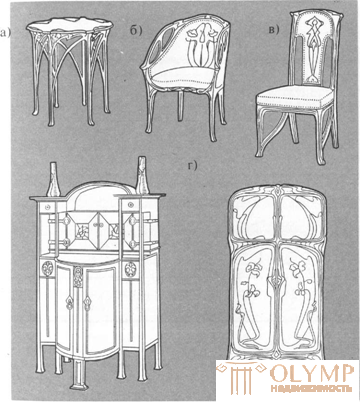
Fig. 1. Examples of furniture in modern style: a - table; b - chairs; in - a chair; g - cabinets
Furniture (Fig. 1) becomes less cumbersome, it is characterized by unique individual solutions, picturesqueness, plasticity of forms. Flowing vegetable lines are widespread, which delineate window bindings, portals, chairs, lamps, and are repeated in household utensils (dishes, serving items), and fabrics. The drawing and ornamental beginning in furniture of the Art Nouveau style masks and sometimes suppresses the product design and architectural elements of the interior. A combination of textures and materials was a characteristic artistic tool for modern furniture. natural textures, painted wood surfaces, inlays of glass and ceramics, polished or laminated metal overlays. Forms and tones are not organized according to the principle of contrast, but according to the principle of repetition, unison.
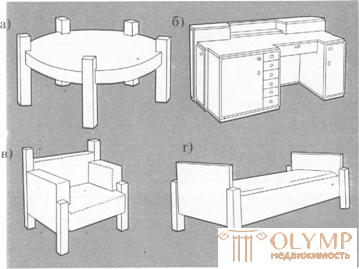
Fig. 2. Examples of Bauhaus furniture: a - coffee table; b - writing desk; in - a chair; d - bed
At the beginning of the 20th century, rationalistic trends in architecture and furniture art developed, which later became known as functionalism. During this period, laconic furniture appears, a sectional collapsible furniture sheet is introduced, special furniture for public buildings is being developed. The principles of functionalism were based on the embodiment of the laws inherent in the forms of machine production. Requirements and laws of technology, along with new materials, such as steel, concrete and glass, through architecture and construction occupied a dominant position.
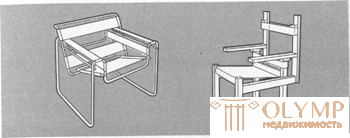
Fig. 3. Chairs by Marcel Breuer
The focus of European functionalism was the Bauhaus founded in Weimar in 1919 by Walter GropiusM. In 1928, Hannes Meyer became his successor, who was replaced by Mies van der Rohe in 1930. After the fascists came to power, the Bauhaus was closed. In Bauhaus crafts were subordinated to architecture. The buildings, their equipment, furniture, and utensils were designed according to technical and social requirements, and established customs were also taken into account. The principles of the Bauhaus were based on a new aesthetics of the material environment, industrial equipment, functionality, the solution of social problems and standardization problems. Within the walls of the Bauhaus in 1919-1933. a large amount of furniture was designed and manufactured (fig. 2). Many designs by Marcel Breuer, in which things are dominated by a constructive beginning and artistic themes close to architectural structures. In the new layout of chairs and armchairs of the bar construction, he tried to either do without the back side door due to the strong connection of the rear legs, or to replace the front wheel side with a diagonal lateral connection, or lower the progres to the floor (Fig. 3).
During this period, special attention was paid to seating furniture, which was intended to play the main role in the rhythmic division of the internal space. Thus, the architect Mies van der Rohe with great care determined the places for chairs and armchairs. He also created a series of chairs and chairs on a metal tubular base. The Barcelona chair, produced to this day (Fig. 4), designed by him in 1929 for the German pavilion at the exhibition in Spain, was best known. It is characterized by excellent operational qualities; it maximally uses the properties of supports made of elastic and springy metal strip. Massive dark leather cushions contrast with the exquisite curved lines of the carcass.
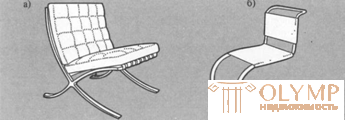
Fig. 4. Chairs Misa van der Ro: a - chair "Barcelona"; b - MR chair
Many prominent architects of the new time also proposed an original solution of chairs and armchairs. For example, the Dutch architect and designer Mart Stamme created a series of wooden stools, chairs and armchairs of centric construction. Collected in a support beam hold the seat, backrest and elbows, which allows you to make the upper part of the rotating. The invention of the Strain marked the beginning of modern bar stools, work chairs and stools.
Finnish architect Alvar Aalto was the first to use plywood in seating furniture. Among the nearly eight dozen models created by him are the most famous chairs with rolling elbows, a lounge chair with a seat and a back of molded plywood and round tables and chairs with curved wooden legs. Furniture Aalto continues the tradition of the world-famous furniture company Artek.
Breaking old Traditions in solving forms of furniture has contributed to the widespread use of metal, which reduced the number of parts and found a simple and accurate form. Marcel Breuer still in Bauhaus designed a chair on a metal base, the prototype of which is considered the furniture of the company “Brothers Tone”, created by Mikhail Tone - the inventor of the new wood processing technology bending. The company manufactures chairs, which, thanks to neutrality, can be placed in different environments. Until now, they are widely used in the interior for any purpose (Fig. 5).
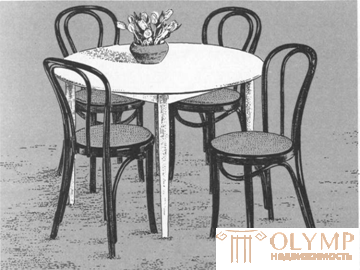
Fig. 5. Chairs M. Tone
A significant influence on the formation of modern furniture for the seat had a chair on metal tubes, designed by Le Corbusier. Thin, but strong frame easily carries the seat. Elements of the composition, depending on the destination, clearly interact with each other (Fig. 6).
One of the features of functionalism is the variety of furniture associated with an increase in the number of building types. The furniture was created for conference rooms, auditoriums, schools and other public buildings. Great attention began to be given to children's furniture, which was no longer decided as a reduced copy of adult furniture and to which they began to add their own features, based on the physiological and psychological characteristics of the child.

Fig. 6. Le Corbusier Chair
The ideas of functionalism are gradually becoming widespread and are being implemented. In new buildings is becoming expedient. The furniture industry develops the production of mass-produced products through the mechanization of production and the use of semi-finished products. The dominant view is that beauty lies in the simplicity of the shape of the object. The course of functionalism was progressive in the furniture art of the 20th century and had a great influence on the formation of the modern style.
“Contrary to popular belief, modern style is not so international at all that products created by designers from different countries cannot be distinguished from each other. Of course, the basic provisions concerning simplicity and expediency in relation to the materials and production methods of our technical era can lead to similar results. Nevertheless, the products of each country, made in a modern spirit, retain an independent character. ” Indeed, even a cursory examination of contemporary furniture samples in a number of countries shows its difference.
Thus, from the very beginning, a new style in Italy was notable for the luxury of middle-class consumers, as it was in Germany, the USA and the Scandinavian countries.
Sweden occupies a leading place among the Scandinavian countries in the field of applied and industrial - art. At the beginning of the twentieth century it had a great influence on folk national art, as exemplified by the Stockholm City Hall, built according to the design of Ragnar Estberg. In it you can find samples of all types of national arts and crafts. The Swedish Pavilion at the 1925 International Exhibition (architect Karl Bergsten) was one of the examples of Swedish modernism. Zaghem there is increasing influence of functionalism, especially when creating cottages and apartment buildings. Applied art developed in Sweden. The Swedish Society of Applied Arts, the Crafts Guild and the Swedish Society of Arts and Crafts were founded. All these associations often arranged exhibitions on the home, played an important role in familiarizing the public with the modern style, were engaged in the manufacture of beautiful inexpensive and comfortable furniture. Back in 1919, the style of furniture in accordance with the national tradition and reflecting the characteristic features of handicrafts was fully formed in Sweden.
Currently, Sweden is one of the leading manufacturers of high-quality furniture in Europe. This country is the founder of shelf and sectional furniture. Already in the 20s, small sets of small-sized furniture began to be made here. A number of firms and institutions are busy resolving issues of complex building equipment. In Sweden, there is a lot of literature on the theory of furniture design. For the manufacture of furniture, especially furniture for public buildings, metal and plastics are widely used.
High culture distinguishes the production of furniture in Denmark. A significant influence on the development of Danish furniture art had Kaar Klint, who since 1924 headed the department of furniture at the Copenhagen Academy of Arts. Denmark specializes in the manufacture of relatively labor-intensive products, the exquisite sculptural details of which (elbows, legs, accessories) are made of solid wood. In Denmark, almost exclusively household furniture is produced, designed for relatively large floor spaces.
Finnish furniture has long won recognition in the global market. Great influence on the development of Finnish furniture art had architects. Finnish artists rely on folk traditions, taking into account the properties of materials and production technology. Compositional and structural solutions in Finnish furniture enable a person to feel free and easy in the interior. Furniture is simple and soft forms. The ratio of colors, textures and textures of different materials is harmoniously aligned. The main material of the Finnish furniture industry is birch. Metal and plastics are also widely used. When finishing wood prevail light colors. Finnish firms carry out orders for complex equipment of public buildings: schools, hospitals, hospitals.
Germany is one of the countries with a developed furniture industry, producing furniture for residential and public buildings. The shape of furniture products is close to the Scandinavian, but more geometric. Metal and plastic are widely used. Recently, there has been a strong tendency to erase faces in the artistic interpretation of furniture for the living room, bedroom and dining room, which is facilitated by a variety of partitions, including mobile ones. For the decoration of furniture used traditional and modern materials and techniques. In Germany, developed public furniture. In particular, much attention is paid to the nomenclature, assor. the type, design, form and decoration of office furniture. In a large assortment of metal furniture is made with working planes of wood.
For English furniture makers, it is characteristic to search for a combination of functional and artistic aspects of furniture products. Quite a significant number of enterprises producing furniture products in the style of the English Gothic of the XV century, Dutch furniture of the XV-XVII centuries, as well as in the style of Chippendel, Heppleuite and Sheraton. In England, open sets for dining rooms and bedrooms are practiced, in which the buyer can choose the composition of the set he needs from a large number of elements uniformly solved in form, decoration, color and texture. French furniture is characterized by a high aesthetic level of composite solutions of individual products, sets and interiors. French interiors and furniture are notable for interesting color solutions, enhanced decorative forms. Solid wood furniture is very popular in France. For household furniture used expensive breeds: walnut, mahogany, rosewood, which are polished, sometimes enriched with carving and inlay. New synthetic materials, metal, chipboard, fibreboard are used for furniture in public buildings.
In the United States in the early 30s, advanced designers and architects designed simple products, trying to save material and labor costs, but only a few entrepreneurs took up their manufacture, and then in small quantities. Cam Weber created a chair made of laminated wood that could be disassembled during transportation, Wolfgang Hof-mann — a tubular metal chair with threaded legs and back, which are one piece, and back legs, turning into a seat — both parts were fastened at four points. Mies van der Rohe, Joseph Aronson and Neisek George Horwitt introduced interchangeable parts, used pillows instead of soft upholstery, and preferred light-washable fabrics instead of leather and woolen fabrics. At present, eclecticism prevails in furniture produced in the USA. In modern furniture products, architectural forms of old England are repeated, close to classic, African and oriental furniture, modernist styles of the late XIX - early XX centuries. Furniture of public buildings, designed with a set of functional requirements for it, has a good performance.
The socialist countries with highly developed furniture industry belongs to Czechoslovakia. The Experimental Institute for the Development of the Furniture Industry (in Brno) is engaged in identifying the direction of the development of the furniture industry, designing new types of furniture, developing technology, mechanizing and organizing production. The institute develops projects of built-in equipment and transformable products (sofa beds, wardrobe beds, wardrobe tables, etc.), small-sized furniture section-block sets based on interchangeable elements.
For veneering products, mainly local breeds are used, which sometimes imitate exotic ones. Much attention is paid to the quality of furniture accessories: constipation, handles, hinges, shelf supports and sliding devices. Bent furniture for the equipment of apartments, offices, restaurants, hotels, schools, kindergartens, etc. continues to be produced in the country. The form and design of such furniture is designed in the spirit of the Tone company established 100 years ago by Mikhail Tone in Moravia. Currently, its tradition continues the association "Ton", which includes enterprises located in Moravia and Slovakia. Bent furniture is notable for a considerable variety of forms, simplicity and clarity of compositional schemes, convenience. Armchairs and chairs are made rigid or semi-rigid. The bent furniture is strong and durable. At the factories "Ton" is also produced children's and theatrical furniture.
A large place in the furniture industry of Czechoslovakia is occupied by metal-frame furniture (Kovona Karvina and Kovona Lisa enterprises), which is widely used in public buildings of mass construction: schools, hospitals, public catering enterprises, etc.
The GDR produces a wide range of household furniture. Forms of furniture products soften. Designers attach great importance to color and textured product solutions. Upholstered furniture is characterized by elegance of forms, straightness of outlines, increased softness. The supporting elements of benches and chairs are made of thin-walled closed steel profiles of rectangular, square or circular cross-section. Plans for designing furniture for public buildings are being developed in the republic, unification, typification and standardization of furniture products are being carried out.
Югославия обладает одним из первых мест в Европе по величине лесного фонда, что создает условия для развития деревообрабатывающей и мебельной промышленности. Общая художественно-стилевая направленность проектирования мебели в стране определяется Институтом прикладного искусства в Белграде, где проектируются и изготовляются образцы современной мебели, разрабатываются проблемы интерьера. Ассортимент бытовой мебели достаточно широк. В производстве используется строганый шпон местных (орех, ясень, “дуб) и тропических (махагони, тик и др.) пород. Для югославской мебели характерны национальные народные традиции.
Отечественный опыт
С середины XIX века в России выпускалась мебель, либо сочетающая в себе элементы разных стилей, либо имитирующая какой-либо стиль прошлых эпох. В конце XIX — начале XX веков мебельное производство испытывает сильное влияние стиля модерн и ложнорусского стиля.
В первые послереволюционные годы серийная мебель продолжала выпускаться главным образом по старым эклектичным образцам. В эти годы попытки создать новую мебель часто имели формалистический характер, сказавшийся во введении гнутых деталей вычурного сложного профиля, больших сложно изогнутых фанерных плоскостей и т. д. Отделка была пестрой и беспредметной. Массовая мебель 1926—1927 гг. освободилась от злоупотребления орнаментом, но сохранила тяжеловесность объемов. Однако уже в этот период в связи с развитием советской архитектуры в области жилищного строительства ведутся поиски путей рационального оборудования помещений и создаются новые модели мебели, разрабатываются жилища нового типа, определяемого новыми социально-экономическими условиями.
In 1925, the Soviet Union participated in the exhibition of decorative arts in Paris. The artist A. M. Rodchenko created a complex of equipment for a working club, including a reading room, a corner of Lenin, equipment for meetings, meetings and speeches, and a live newspaper. The equipment (Fig. 7) included shields, various combinations of which allowed creating the necessary exposition surface and organizing the space. The furniture was notable for its novelty of the solution, simplicity and even asceticism of the form, its correspondence to its functional purpose. Work Club Rodchenko can be considered the first example of a complex interior realized in nature in Soviet architecture.
Prominent architects of that period (K. S. Melnikov, I. I. Leonidov, the Vesnin brothers, etc.) paid great attention to the internal equipment of the buildings they were building, and designed industrial and club furniture for them.
An example of finding the most appropriate utilitarian equipment was the rationalization of the kitchen.
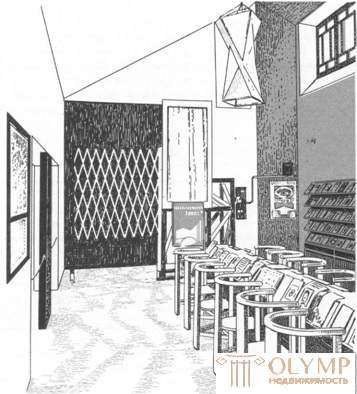
Fig. 7. Furniture in the interior of the club A. M. Rodchenko
Construction Committee of the RSFSR in 1928-1929 developed a new type of housing. An analysis of the premises of apartments showed that with the rationalization of equipment, their size can be reduced [13, 14]. For a more rational use of space in small apartments, the kitchen was replaced with a niche occupying a minimum area of 1.4 m2. Appropriate equipment niche allowed to work in it with sufficient convenience. At the end of the work, the kitchen niche was closed with a curtain hiding the kitchen equipment. The development of furniture art in the 30s was greatly influenced by the resolution of the Council of People's Commissars of the USSR on improving the quality of housing construction and the decision of the First All-Union Congress of Soviet Architects in 1937, which provided for a significant improvement in the decoration of apartments, their interior equipment and furniture. Furniture for home equipment has been designed in accordance with the nature of architecture. The proportions of the furniture of that time, the presence of eaves, gables, pilasters, plinths indicate the repetition of the architecture of a residential house.
In 1932 the All-Union competition for new furniture was held. The competition was presented in a variety of samples combined as well as sectional furniture, based on the principle of different combinations of repeated elements and the possibility of making options by the consumer. The design of furniture during this period was subordinated to the requirements identified for it, namely: the correspondence of the sizes of linear and volumetric values to the set of stored things (mainly for cabinet furniture); according to the size of furniture products and their parts (seat height, backrest height, table height, etc.) anthropometric data.
Great attention is being paid to the design and manufacture of furniture for large public facilities under construction. The development of furniture for public buildings in Moscow was carried out by the 12th art workshop of the Moscow City Council under the direction of N. G. Borov, who designed, for example, the Pravda factory, and the design workshop Isorama in Leningrad. The building of the Pravda combine was built according to the project of P. A. Golosov. All rooms are equipped with furniture and lighting fittings specially made for the plant. Samples of electrical fittings were developed by the artist A. I. Damsky. The project is an undoubted achievement, as it solves the problem of architectural and artistic decoration of the interior of the whole plant.
When designing furniture for public buildings, they strive to use the classic heritage. An example is the furniture created by architects V. Simbirtsev and K. Blomerius for the theater of the Soviet Army in Moscow. The previously designed furniture of the Moscow Hotel (architects L. Saveliev and O. Stapran) also illustrates the search for the development of Soviet furniture based on the study of the classical heritage.
Since the end of 1939, the Academy of Architecture of the USSR has begun systematic work on the design of furniture. A brigade composed of architect-engineer V.A. Andrievsky, architects L. 3. Cherikover, N.V. Bogoslovsky, L.N. Kisilevich, and others engaged in the development of residential furniture. By the beginning of the 1940s, the problem of developing the internal ensemble of a home, achieving stylistic unity and matching the internal equipment of a home to the external appearance of a structure, synthesizing architecture and applied arts was seriously raised.
In the first post-war years, the furniture was made on preserved pre-war equipment, mainly according to the old models. However, a number of measures to strengthen the production base of the furniture industry made it possible to increase the output of furniture by the end of 1949 by 2 times compared with the pre-war level.
Organized in 1949, the All-Union Conference of Workers in the Furniture Industry, summing up the work, outlined ways for further development of the industry. In the 40-50s, furniture enterprises began to produce series and sets of furniture. In 1952-1953. the production of a set of sectional furniture was developed (author N. A. Luppov) with a single architectural and artistic solution that includes all types of products necessary for furnishing an apartment, one room or a part of it. The advantage of a set of furniture in comparison with the set was that the buyer could complete his composition at will.
In the 1950s, the production of high-quality furniture for unique public buildings increased (for the Moscow Academic Maly Theater, for the new building of Moscow State University), large sets of various special-purpose furniture for GUM were made, etc. Considerable attention was paid to architectural design. -planning composition of apartments, their decoration, as well as the problem of interiors of the Soviet dwelling as a whole. An example could be the residential house of architect I. V. Zholtovsky, where embedded equipment was used for residential apartments. Thanks to the device of a sliding partition, small front and living rooms could be connected into one space. The bedrooms were equipped with built-in wardrobes for various purposes (Fig. 8).
The repetition of the forms and designs of past epochs could not be the main focus of modern furniture design, which had to respond to changed living conditions, new constructive and technological capabilities of the industry. A major role in the radical restructuring of the design and manufacture of furniture was played by the resolution of the Central Committee of the CPSU and the Council of Ministers of the USSR of November 4, 1955 "On the elimination of excesses in design and construction."
In December 1956, the All-Union Conference of Workers in the Furniture Industry was held, which was preceded by an exhibition of furniture, organized in accordance with the new requirements in September 1956 in Moscow. The exhibition showed prototypes of furniture developed by the Academy of Construction and Architecture of the USSR, the Moscow Higher School of Industrial Art (formerly Stroganov), as well as the design bureaus of ministries and departments. Foreign samples of mass production were also shown. The exhibition helped outline the further development of the design and industrial production of furniture.
The greatest approval at the exhibition received a number of sets. These included sets of sectional furniture H-30 and H-62, developed by the Central Furniture Design Bureau (CMCB, chief designer A. M. Strongin). The H-30 set (author E.S. Orlova-Bocharova) included five main types of sections, the combination of which could give more than 20 various items of cabinet furniture. This set was also presented at the Moscow exhibition of new construction equipment in 1957, and then shown in a model of an apartment in the USSR pavilion at the World Exhibition in Brussels in 1958. The H-62 set also differed in its high functional and artistic qualities (by Yu. V Sluchevsky) and a set of sectional furniture (author N. A. Luppov), manufactured at the Vilnius furniture factory and recommended for serial production. The principle of sectioning, embodied in the case products of the marked sets, opened the possibility of a broad search for more expressive forms of products while maintaining their manufacturability.
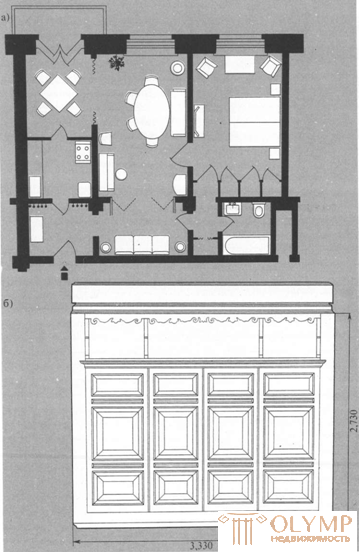
Fig. 8. Built-in equipment of a dwelling house: a - plan of a typical residential section; b - built-in wardrobes
However, the mass furniture, despite the work carried out to improve its structures, remained cumbersome and occupied 45-50% of the floor area, did not match the layout and dimensions of the new single-family apartments.
In 1958, the USSR State Committee on Construction on behalf of the Soviet Government held the First All-Union Competition for the Best Samples of Household Furniture, the main purpose of which was the creation of new furniture models for one, two
Что бы оставить комментарий войдите
Комментарии (0)